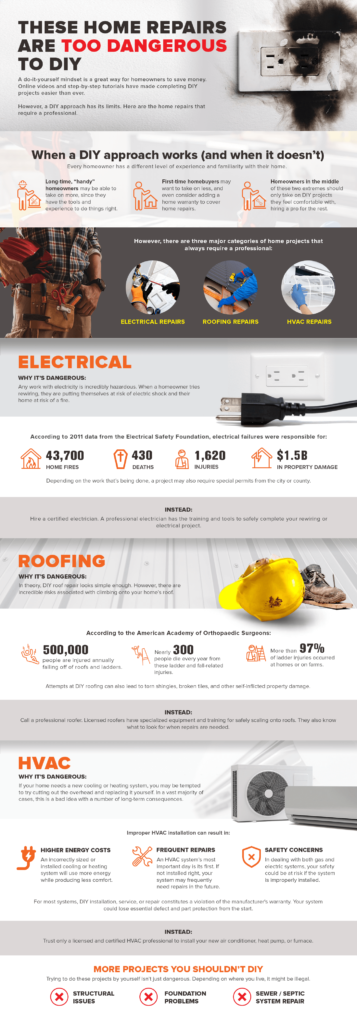Home Repairs
Have a professional help you with these home repairs
We’re living in a do-it-yourself (DIY) golden age. Type any home repair question into your search engine, and you’ll see why. There are thousands of online tutorials and step-by-step guides out there. From snaking a clogged shower drain to patching drywall, homeowners can learn to do just about anything on their own. That’s saving all of us a lot of time and money!
However, this DIY philosophy has its limits. There are some types of repairs that are just too dangerous or risky to handle yourself. In this article, we’ll review a few critical projects best left to the pros. Let’s take a closer look.
HVAC
Noticing problems with your AC or furnace? Is your air conditioner struggling to cool down your home on hot summer nights? If so, you’ve probably given some thought to trying to fix it yourself. After all, there are dozens of online tutorials where they walk you through every step of the process. How hard could it be?
The answer to that rhetorical question is often “very.” Heating and cooling repair is not for beginners—there’s a reason why HVAC technicians go through extensive training before heading out into the field. Repairing an air conditioner, furnace, or heat pump requires the correct tools, the right replacement parts, and the expertise to then put everything back together. Many homeowners who attempt DIY repairs end up having to call in a professional to try and clean up the mess they’ve created.
In addition to potentially damaging your system, there’s another major reason to stay away from completing your own repairs: your system’s warranty. Opening up your own air conditioner or furnace will likely void the manufacturer’s warranty, right off-the-bat. You don’t want to lose this critical warranty coverage, which protects major components such as the AC compressor from premature failure.
Roofing
For obvious reasons, roofing can be incredibly dangerous. All it takes is one slip to change your life forever. Unfortunately, many homeowners underestimate just how risky ladders and roofs are. Here’s the bottom-line: you do not have the right safety equipment, shoes, or tools to be climbing onto your own roof. A licensed roofer does, which is why you should always bring in a professional if you suspect your roof needs repairs.
Your safety aside, repairing a roof is more difficult than it initially looks. First, you need to know what to look for—how do you tell where you need to make repairs? How do you spot non-obvious signs of damage? Then, assuming you’ve found the problem, you’ll need to repair the shingles and underlayment without damaging other parts of the roof. DIY roof repairs tend to end with the homeowner causing more damage to the roof, which they only realize the next time it rains or snows.
Electrical
If you’re dealing with electrical outlets, appliances, or wires, always call in a licensed electrician. It’s not just about your own safety—although far too many American homeowners electrocute themselves every year. It’s about the safety of your home. Incorrectly grounding a wire, or running too much through one circuit, could lead to an electrical fire. Simply put: the stakes are too high, and the hourly cost of an electrician is worth every cent.
Not all home repairs are as dangerous or risky as the three listed above. In fact, there’s a lot you can do to repair and maintain your home on your own. It’s just important that you know your limits. If you feel like you’re unprepared, don’t have the right tools, or are potentially doing something wrong or unsafe, stop. Take a step back and reassess whether you’re the right person for the job.
To learn more about potentially unsafe DIY projects and repairs, check out this new infographic. It takes a closer look at the three types of projects reviewed above.

